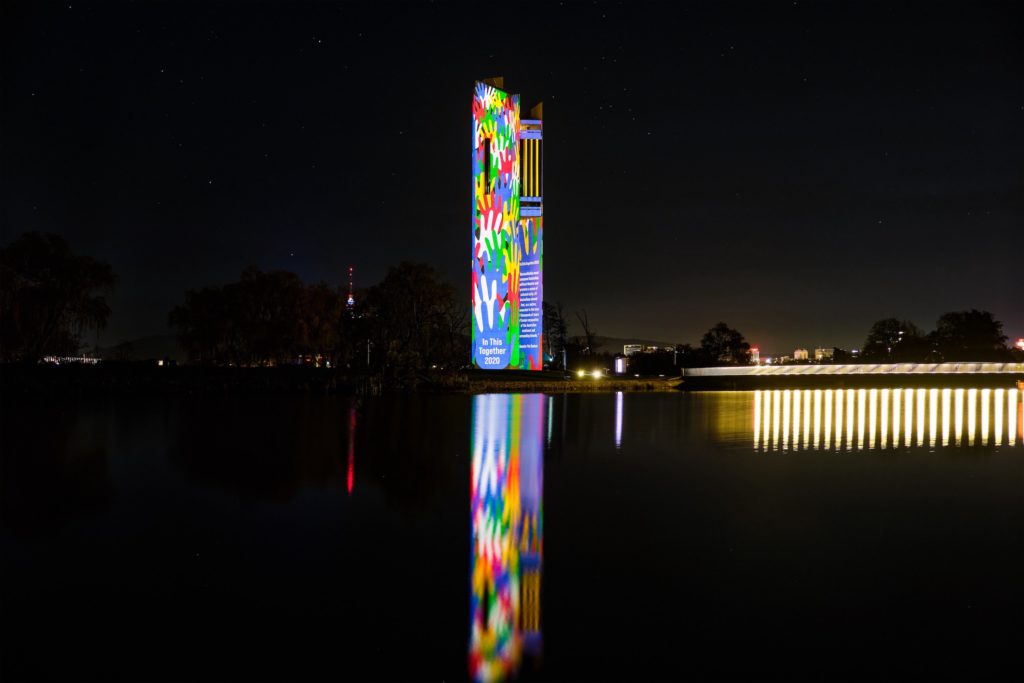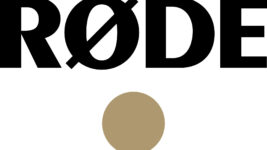News
13 Jul 2020
The Light on The Hill – The Electric Canvas map The National Carillon for Reconciliation Week

Subscribe to CX E-News
It’s been an interesting few months for The Electric Canvas in Canberra.
After finishing up work on the Enlighten festival in mid-March, the National Capital Authority (NCA) asked TEC to have a look at the National Carillon on Lake Burley Griffin’s Aspen Island.
The spectacular 60 metre tower that houses our national bell instrument is turning 50, and has been fitted with two new bells; one tiny high D, and one truly enormous low G named the Ngunnawal Bell after the land’s traditional custodians.
Fittingly, the bells were cast and installed by the same English company that cast the originals. The NCA were planning a bit of projection mapping to celebrate the re-opening. Then, of course, the lockdown.
The English bell fitters promptly exited the country, literally leaving their tools in the tower. The mapping event was of course cancelled. Having done preliminary measurements and site scoping, MD of TEC Peter Milne was now itching to aim his projectors at the stunning monument.
Peter reached out to the NCA with the idea to produce a projected tribute to the frontline workers of the pandemic, and got the go-ahead. After driving to and from Canberra (no flights, of course) and finishing their survey, the tribute was shut down three days before bump-in.
An ANZAC Day projection was suggested. That was a no-go too. Never say die. A month later, the NCA contacted TEC and floated the idea of projection on the Carillon during Reconciliation Week. It would be over eight nights, with each night dedicated to a different artist, community, or organisation. The catch was that TEC would only have two weeks to create the content and get the site ready.
“Culturally sensitive work with a lot of stakeholders involved usually takes months,” says Peter Milne. “It’s a lot of time, and a lot of people. We decided to take on the challenge. The first step was briefing the participants and explaining how a projection on this type of structure works; it’s not just putting someone’s painting up on a flat wall.
“The Carillon is 60 metres high and made of three triangular columns that are six metres wide on each facet.”
The next challenge is working out how it would look to the viewer, who could be almost anywhere around the Parliamentary Triangle. “We had to figure out how it would look when you see half of column A and half of column B.
“We couldn’t travel, so we had a local tech go to select viewing spots we marked on a map and take vantage point photos so we could strategize. As the island was closed to the public, the closest viewing spot was 150 metres away.
“On the other side of the lake, you’d be viewing it from 850 metres away. The content, especially the content with messaging or branding, had to make sense from different angles and distances. We had to educate the participants on what limitations they had to work with, and what the opportunities were.”
Peter held the initial meetings with the participating organisations and artists, then the TEC team took over. All design and creation was handled in house by art director Richard De Souza and junior designer Gisele Nour. The huge volume of communication required to make the project work was the responsibility of content producer Jacqueline Livermore.
Having done preliminary measurements and site scoping, MD of TEC Peter Milne was now itching to aim his projectors at the stunning monument
TEC set-up four projection towers, each home to three 25K Christie Crimson laser projectors running in portrait mode. Media was handled by TEC’s Modulo Kinetic media server system with full hot back up. As Aspen is an exposed, inhospitable island with no shelter, TEC commandeered the top level of the Carillon, known as the Viewing Room, to house their site tech.
Surveillance cameras were trained on the towers and fed back to a multiviewer for the on-site tech to monitor.
Days before opening night, restrictions were lifted slightly, and the NCA decided to allow groups of 10, mainly the participants and their families, onto the island while the projections ran. “This created an opportunity to present something more intimate with a lot of detail that could be seen close-up,” relates Peter.
“The tower locations were chosen when we thought the island would be open, so we already had a clean shot at an internal facet. This allowed us to project text and explanatory items on an internal facet that you couldn’t see from anywhere else.”
Date: Wed 27th May 2020
Title: Reconciliation, a continuing journey of growth and togetherness
Artist/Contributor: Artist: Nikita Ridgeway. Narrative created by: Reconciliation Australia
Description: The artwork is by Nikita Ridgeway of Boss Lady Design and Communications. The artwork’s design elements represent Australians together on a national journey of reconciliation, while paying homage to the past and recognising the present.
Date: Thurs 28th May 2020
Title: 2000 Walks for Reconciliation – In this Together
Artist/Contributor: Image: Montage of various photographs by Glenn Campbell/Newspix, News Ltd/Newspix, Brian Condron/Newspix, Richard Cisar-Wright/Newspix). Narrative created by Reconciliation Australia
Description: ‘2000 Walks for Reconciliation – In this Together’, is a montage of imagery from the 2000 Reconciliation Walks across Australia. The People’s Walk for Reconciliation (as the bridge walk was titled) had a profound impact on those who participated, and a roll-on effect around the country. The 28th of May 2020 marks the 20th Anniversary of the first Reconciliation Walk.
Date: Fri 29th May 2020
Title: Voice Treaty Truth
Artist/Contributor: Image: The 3 themes of the Uluru Statement from the Heart. Narrative created by: ACT Reconciliation Council
Description: ‘Voice Treaty Truth’ – The Uluru Statement from the Heart is an invitation from Aboriginal and Torres Strait Islander people to “walk with us in a movement of the Australian people for a better future”. It inspires this artwork.
Date: Sat 30th May 2020
Title: Sea of Hands
Artist/Contributor: Artist: Australians for Native Title and Reconciliation (ANTaR). Narrative created by ANTaR, Senator Pat Dodson, Dr Jackie Huggins AM
Description: In 1997, not far from the Carillon on Federation Mall, thousands of Australians came together to plant a Sea of Hands in solidarity with First Nations peoples to stand up for their land rights. Over two decades later, our Hands in Reconciliation are still going, even digitally.

Date: Sun 31st May 2020
Title: Galambany
Artist/Contributor: Artist: Richie Allan. Narrative created by the United Ngunnawal Elders Council & Winanggaay Language Group
Description: ‘Galambany’ The story of the Artwork is about Mother Earth gifting the three rivers that flow into Canberra. Ngunnawal people breathed life into these rivers and the rivers gave life to the Ngunnawal people.

Date: Mon 1st June 2020
Title: ACT Reconciliation Day
Artist/Contributor: Artist: Lynnice Church. Pledge content developed by ACT Reconciliation Council
Description: Canberran and Ngunnawal, Wiradjuri and Kamilaroi artist Lynnice Church created this artwork for the city’s Reconciliation Day. Lynnice’s artwork embodies the essence of reconciliation, equity and understanding. As well as showcasing Lynnice Church’s artwork on the Carillon, these projections incorporate Reconciliation pledges made by the Canberran community. All Canberrans were asked to make a pledge and demonstrate their support and commitment towards Reconciliation.
Date: Tues 2nd June 2020
Title: Trio of Flags
Artist/Contributor: Image: Montage of the Australian Flag, Aboriginal Flag, Torres Strait Island Flag. Narrative created by ACT Reconciliation Council
Description: ‘Trio of Flags’ – Flying the Aboriginal and Torres Strait Islander flags shows respect. We acknowledge First Nation peoples, build community partnerships and demonstrate our commitment towards reconciliation. Credits: © Copyright Harold Thomas 1971. Aboriginal flag reproduced digitally with the permission of WAM Clothing.
Date: Wed 3rd June 2020
Title: Mabo Day
Artist/Contributor: Artist: Gordon Bennett with permission from NPG and The Estate of Gordon Bennett and Gail Mabo
Description: This artwork celebrates Mabo Day, and was projected on the anniversary of the historic Mabo decision in 1992. On 3 June 1992 the High Court of Australia delivered its landmark Mabo decision, which legally recognised that Aboriginal and Torres Strait Islander peoples have a special relationship to the land.
Credit: Eddie Mabo (after Mike Kelley’s ‘Booth’s Puddle’ 1985, from Plato’s Cave, Rothko’s Chapel, Lincoln’s profile) No.3 1996 by Gordon Bennett. Collection: National Portrait Gallery, Australia. © Gordon Bennett Estate. With thanks for permission from The Gordon Bennet Estate and Gail Mabo.
CX Magazine – July 2020
LIGHTING | AUDIO | VIDEO | STAGING | INTEGRATION

Entertainment technology news and issues for Australia and New Zealand
– in print and free online www.cxnetwork.com.au
© VCS Creative Publishing
Subscribe
Published monthly since 1991, our famous AV industry magazine is free for download or pay for print. Subscribers also receive CX News, our free weekly email with the latest industry news and jobs.












